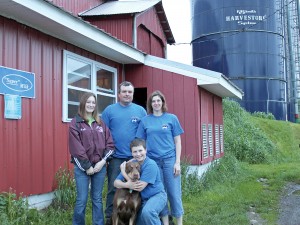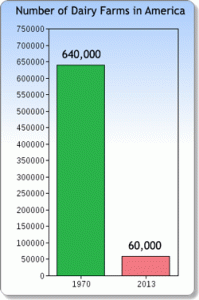September 2013
Dear Farm Aid,
I watched the webcast of Farm Aid 2013 and was really moved by the call to action to support family farmers in my home state. I know that dairy is big here and family dairy farmers seem to be struggling. What can I do to help?
Thanks,
Karen
Jasper, NY
Well Karen, like you, we were moved and impressed by all that is going on in Saratoga Springs, New York, and the entire Upstate New York region. The Good Food Movement is strong there and serves as an inspiration for communities across the country looking to better support and rally around their family farmers.
This year’s Farm Aid concert brought us to a major center of dairy production in the United States. New York State ranks fourth in milk production and leads the country in yogurt production.[1] Our time there showed us that the triumphs and challenges of dairy farmers in Upstate New York are echoed around the country.
In fact, America has seen a seismic shift in how our milk and dairy products are produced. Since 1970, the number of dairy farms has dropped by more than 90 percent, from 640,000 to under 60,000 today. The reason why is fairly straightforward: in an industry dominated by corporate interests and bad policy, family dairy farms are constantly at risk of going under. Let’s dig into why.
A Sour Pricing System
The dramatic loss of family dairy farms is the result of an outdated and unfair pricing system. To get a sense of just how messed up it is, consider that the federal milk price, which helps dictate how dairy farmers are paid across the country, is set by a dizzying formula that is several pages long. That is to say, it’s fairly indecipherable and doesn’t take into account what actually happens on the farm. To makes matters worse, our milk pricing system is prone to heavy manipulation by major dairy corporations and processors who stand to benefit from low milk prices.
The result is a widening gap between what farmers are paid for their dairy products and what consumers pay at the checkout. For example, between 1998 and 2007, dairy farmers saw their share of the retail milk price drop 25 percent, even while retail prices increased by 40 percent. Corporate dairy processors, meanwhile, earned windfall profits. Today, dairy farmers receive just $1.66 for a gallon of skim milk that retails at $4.69, with the difference going to middlemen and corporate processors.[2]
To add insult to injury, dairy farmers are often paid prices far below their cost of production—leaving them at a loss each time they sell their milk. Until our farmers’ receive a fair price above their cost of production to ensure a living wage, our dairy farmers remain at risk.
Roller Coaster Years Leave Farmers High and Dry
Recent drought conditions and rising feed costs have tightened the financial squeeze on dairy farmers, leaving the future of their farms uncertain.
In 2009, the milk market tanked, with prices plummeting and droves of family dairy farms closing their doors. While milk prices recovered somewhat in 2010 and 2011, the recovery was not enough for farmers to recover the previous year’s losses. Prices dipped again in 2012 just as persistent drought—the worst seen in the U.S. since the 1950s—plagued dairy farmers and caused the cost of feed to skyrocket. In the worst months of 2012, dairy farmers were losing up to $8.65 per hundredweight (one-hundred pounds, or roughly 12 gallons) of milk they produced,[3] putting their farms in jeopardy and dramatically impacting rural economies.
So far in 2013, milk prices are hovering near $19.00 per hundredweight—sometimes enough to break even, but not nearly enough to recover losses from the last several years or maintain or invest in important infrastructure on the farm. We stand at a tipping point—aggressive action from our government to fix corruption and bad milk price policy is essential, as is the dedication of eaters to seek out new ways to support local dairy farms.
What is Farm Aid Doing to Address the Crisis?
Farm Aid has stood side-by-side with farmers to advocate for pricing reform and antitrust enforcement in the dairy industry. We met with U.S. Secretary of Agriculture Tom Vilsack in 2009, delivering petitions signed by more than 13,000 farmers and eaters calling on the USDA to establish a fair floor price for milk. In 2010, when the USDA and Department of Justice launched a series of public workshops to examine anticompetitive conditions in agriculture, Farm Aid attended each one, even donning a cow suit to draw attention to the injustices facing America’s family dairy farmers.

Deb Windecker, of New York’s Windex Farm, has spoken out on behalf of dairy farmers and worked to remind consumers that farmers are behind all of the food they eat. Read our Farmer Hero profile of Deb to learn more.
As dairy farmers continue to struggle, Farm Aid continues to raise awareness about the dairy crisis. On the day before the Farm Aid 2013 concert, Farm Aid hosted a tour of Willow Marsh Dairy in Ballston Spa, NY, to spotlight how dairy farmers are using value-added dairy products to reach new customers and meet the local demand for their milk as a way to stay in business. The event yielded meaningful discussion about the challenges family dairy farms face in New York and across the country and how farmers, like our three dairy Farmer Heroes this month, are innovating to address them.
In addition, Farm Aid has provided emergency funds to dairy farm families in crisis, supported dairy farmers organizing rallies nationwide, and funded trips to the U.S. Capitol to highlight the impacts of losing our family dairy farms.
What you can do:
For eaters, the loss of local dairies limits our access to fresh, local milk products, impacts the health of our local economy, and often means a permanent loss of precious farmland to development. With fewer family farmers, the fate of our dairy products is left in the hands of factory farms and giant milk processors who have repeatedly cut corners with additives and processes that compromise the health and safety of milk.[4]
If we want fresh, healthy, local dairy products, we need our dairy farmers to stay in business. Seek out local sources for your dairy products and participate in the markets that can return a higher price to the farmer, supporting the farm and your community.
And, please join the efforts of Farm Aid and organizations like the National Family Farm Coalition and Family Farm Defenders to hold our government accountable to ensuring fairness for family dairy farms. The USDA has the authority to adjust milk prices to better support farmers’ financial viability. Many dairy farmers have been calling for this for years, and continue to request a federal hearing to finally and officially fix the milk pricing system.
Sources
1. Vosburgh, Robert. May 13, 2013. Yogurt Alley: N.Y. surpasses Calif. As Top Yogurt-Making State.Supermarket News.
2. National Farmers Union (2013). The Farmer’s Share.
3. Kardashian, Kirk. October 5, 2012. “Global Warming, Dairy Farmers, and the Do-Nothing Congress.“US News & World Report.
4. Food & Water Watch. Milk Protein Concentrates; International Business Times (2013). “Aspartame in Milk: Big Dairy Wants to Sneak in Sweeteners Without Labels.”
Further Reading
- Read our Farmer Hero profiles of three New York dairy farmers for more perspective on the current state of dairy farming in America: Carroll Wade, Chuck Deichmann and Deb Windecker.
- Check out our Dairy: Family Farmers in Crisis fact sheet for additional information.


